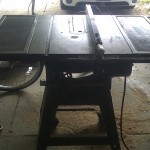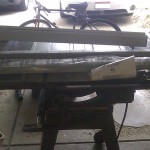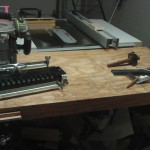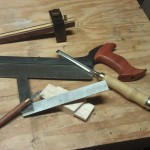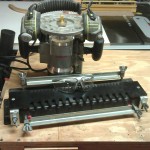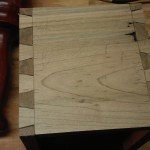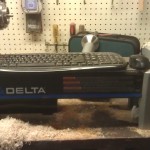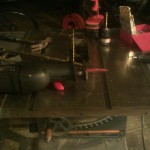 Before I could start the install I had to remove the old fence. Despite the bolts for the old fence rails being a little rusty, they came out fairly easily. I found however that the wings had bolts that had rounded heads that needed to come out as well, otherwise the angle irons for the new fence would not be able to sit flush to the TS. Out 9 of these bolts 1 came out easily. Using some WD-40 and slotting the bolt heads with the dremel, I was able to get 6 more out. The last two….. Well they were a bit stubborn. The picture speaks for itself as to what it took to get those suckers out. (Fear not, none of theses tools were used anywhere near the cast iron table…. yet)
Before I could start the install I had to remove the old fence. Despite the bolts for the old fence rails being a little rusty, they came out fairly easily. I found however that the wings had bolts that had rounded heads that needed to come out as well, otherwise the angle irons for the new fence would not be able to sit flush to the TS. Out 9 of these bolts 1 came out easily. Using some WD-40 and slotting the bolt heads with the dremel, I was able to get 6 more out. The last two….. Well they were a bit stubborn. The picture speaks for itself as to what it took to get those suckers out. (Fear not, none of theses tools were used anywhere near the cast iron table…. yet)
 At this point, if this had been a Delta table saw, this fence would have very easily bolted up to the saw. However, since the saw is a Craftsman, none of the holes in the saw lined up with the holes in the angle iron. I could potentially use the closest matching hole, but the tape measure would be about an inch off. Therefore I needed to drill a few new holes, I just needed to figure out where. First thing I did was raise the blade up so that it was taller than the new fence, and placed the fence right against the blade. Looking at the indicator line on the fence indicated approximately where there rail needed to lined up so zero would be within the adjustment zone of the scale. I marked the position on the saw using a red china pen. Next I screwed the tube rail to the angle iron, and then aligned the zero point to the red mark on the saw. From there I was able to mark the hole positions in the table saw top based off the positions in the angle iron. I then knew where I needed to drill.
At this point, if this had been a Delta table saw, this fence would have very easily bolted up to the saw. However, since the saw is a Craftsman, none of the holes in the saw lined up with the holes in the angle iron. I could potentially use the closest matching hole, but the tape measure would be about an inch off. Therefore I needed to drill a few new holes, I just needed to figure out where. First thing I did was raise the blade up so that it was taller than the new fence, and placed the fence right against the blade. Looking at the indicator line on the fence indicated approximately where there rail needed to lined up so zero would be within the adjustment zone of the scale. I marked the position on the saw using a red china pen. Next I screwed the tube rail to the angle iron, and then aligned the zero point to the red mark on the saw. From there I was able to mark the hole positions in the table saw top based off the positions in the angle iron. I then knew where I needed to drill.

